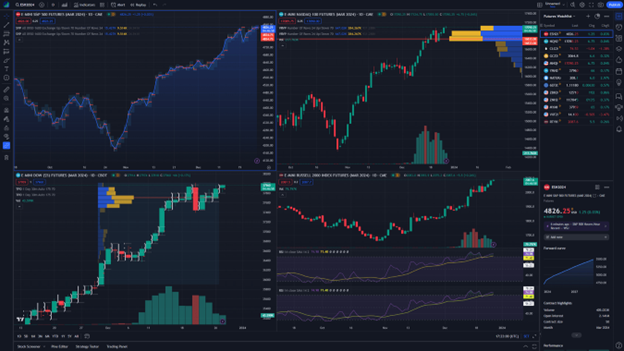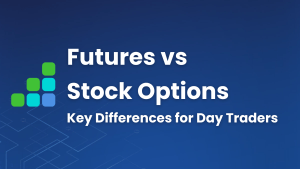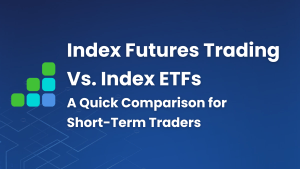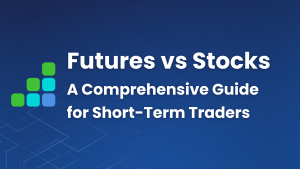The article on the Best TradingView Indicators is the opinion of Optimus Futures, LLC.
Speed is a must in any competitive sport. It is not only accurate in sports but also true in day trading decision making. But in order to make quick decisions, you need to have the right tools at your disposal.
This is where the synergy between Optimus Futures and TradingView’s advanced charting tools truly shines.
As a futures trader, having access to a platform that not only provides comprehensive analytical tools but also seamless trade execution and real-time data is crucial.
In total, there are over 100 indicators available on TradingView, not including the hundreds of custom indicators written by individual traders.
While that sounds awesome, it can also be very overwhelming.
That’s why we’ve decided to share with you what we consider the four best TradingView indicators for day trading futures.
Best TradingView Indicators
1. Best TradingView Indicators: Volume Profile HD
The Volume Profile HD indicator is a critical tool for visualizing trading activity in the futures market.
Available on TradingView via Optimus Futures, it provides a deeper understanding of market structure and liquidity.
This indicator is handy for popular futures contracts like the E-mini S&P 500 (ES) and Crude Oil (CL).
Understanding the Volume Profile HD Indicator
The Volume Profile HD calculates and aggregates trading activity at distinct price levels over a specified period.
It visually represents this distribution on the price chart, highlighting areas where the market has shown the most interest.
This includes the Value Area, comprising a specified percentage of total volume, and the Point of Control (POC) – the level with the highest volume.
These aspects are crucial for identifying key support and resistance levels, making informed trading decisions, and understanding market sentiment.
Practical Application in Day Trading
Key Support and Resistance Levels: Volume Profile HD is adept at pinpointing significant support and resistance levels in futures markets. High Volume Nodes (HVN) often act as robust support or resistance zones, while Low Volume Nodes (LVN) may indicate weaker areas. This insight is critical for making precise entry and exit decisions.
Spotting Breakouts and Breakdowns: In fast-moving futures markets, identifying breakouts with high volume can signal a shift in market sentiment, offering potential entry points for day traders.
Trend Confirmation: Volume Profile can confirm existing trends, particularly useful in volatile futures markets. For instance, in an uptrend, more volume at higher price levels can validate the trend’s strength.
Trade Management: Utilizing Volume Profile for setting profit targets and stop-loss levels might enhance trade effectiveness. For example, placing stop-loss orders below significant volume levels may offer protection against adverse price movements.
Combining with Other Indicators: To refine trading strategies further, Volume Profile HD can be paired with other technical tools, such as moving averages or Fibonacci retracement levels, providing a more comprehensive analysis.
Analyzing Market Sentiment: The shape and location of the volume profile can offer insights into market sentiment. A balanced profile suggests equilibrium, while an asymmetrical one may indicate a strong directional bias.
Fine-tuning Entry and Exit Points: Volume clusters, where multiple high-volume nodes are close, can indicate significant areas for potential trade entries. Observing how price reacts to these clusters and other technical indicators can provide more precise entry and exit points.
2. Best TradingView Indicators: Supertrend Indicator
The Supertrend Indicator is a trend-following tool that becomes especially powerful for futures trading when accessed through Optimus Futures on TradingView.
It excels in providing clear, actionable signals in various futures markets, including the likes of the Micro E-mini Nasdaq-100 (MNQ) and the E-mini Dow Jones (YM).
The indicator helps traders quickly discern bullish or bearish trends, offering a straightforward approach to real-time adaptation of trading strategies.
This feature, combined with the high-speed execution of Optimus Futures, is invaluable for day traders looking to stay ahead in the dynamic futures market.
This trend-following tool is powered by two critical dynamic values, period and multiplier, and is underpinned by the concept of Average True Range (ATR), a measure of market volatility.
How the Supertrend Indicator Works
The essence of the Supertrend Indicator lies in its use of ATR, which assesses market volatility by analyzing the range of prices for a security over a specific time.
The true range (TR) is calculated as the highest of the current high minus the current low, the absolute value of the current high minus the previous close, and the absolute value of the current low minus the previous close.
To determine the ATR, a series of TR values are first calculated and then averaged over a chosen number of periods. This results in the moving average of true ranges. The Supertrend Indicator combines this ATR value with a set multiplier to generate buy and sell signals, which are visually represented on price charts.
Application in Day Trading Futures
Trend Identification: The Supertrend Indicator excels in providing clear, actionable signals, helping traders quickly identify bullish or bearish trends. This is particularly crucial in the fast-paced environment of futures day trading, where understanding market direction is key to successful trades.
Real-Time Strategy Adaptation: As futures markets can be highly volatile, the Supertrend Indicator’s ability to offer real-time trend information allows traders to adapt their strategies swiftly. This responsiveness is essential for day trading, where market conditions can change rapidly.
High-Speed Execution with Optimus Futures: When coupled with the high-speed execution capabilities of Optimus Futures, the Supertrend Indicator becomes even more powerful. It ensures that traders can act on the signals generated with efficiency, which is critical in markets like futures where timing is everything.
Risk Management: By providing clear signals based on market volatility and trend, the Supertrend Indicator aids in effective risk management. Traders can use these signals to set stop-loss orders and manage their positions more effectively, a vital aspect of day trading.
Enhanced Decision Making: The combination of ATR and the indicator’s algorithm offers a nuanced understanding of market dynamics. This enhanced view can guide traders in making informed decisions, particularly in choosing entry and exit points in futures trading.
3. Best TradingView Indicators: RSI
The RSI, when used in conjunction with TradingView through Optimus Futures, becomes a formidable tool for futures traders. Its utility in identifying potential price reversals is unparalleled, especially in volatile markets like Natural Gas (NG) and Gold (GC).
The customizability offered on TradingView allows traders to fine-tune the RSI settings to fit various trading styles and market conditions.
When integrated with the robust trading infrastructure of Optimus Futures, it empowers traders to make well-timed and informed decisions in the futures market.
This indicator, developed by J. Welles Wilder Jr. in the late 1970s, is particularly effective in markets like Natural Gas (NG) and Silver (SI).
Its simplicity in indicating overbought/oversold conditions and its adaptability across various markets and time frames make it a staple in futures day trading.
Understanding the RSI Indicator
The RSI aims to provide a straightforward method to gauge overbought and oversold conditions in the market. It operates on the principle that in an uptrend, there will be more up closes (current close greater than the previous close) than down closes, and vice versa in a downtrend.
This indicator calculates the ratio of these up moves and down moves over a specified lookback period, typically using a 14-bar exponential moving average (EMA). The resulting RSI values range between 0 and 100, with readings above 70 indicating overbought conditions and those below 30 suggesting oversold conditions.
How RSI Enhances Futures Day Trading
Overbought/Oversold Signals: In fast-paced futures markets, RSI provides critical signals about potential exhaustion points in trends.
For example, an RSI reading crossing back above 30 might suggest the end of a bearish trend in Silver futures, while a reading falling below 70 could indicate a potential reversal in an uptrending Natural Gas market.
Identifying Divergence: RSI is invaluable for spotting divergences – scenarios where price movement and RSI trends do not align.
Bearish divergence (higher highs in price but lower highs in RSI) may signal a potential reversal to the downside, which is crucial for day traders to identify turning points.
Customizability for Different Market Conditions: Traders can experiment with different lookback periods and overbought/oversold levels on TradingView through Optimus Futures. This flexibility allows the RSI to be tailored to the unique characteristics of various futures markets.
Integration with Other Indicators: Combining RSI with volume and volatility indicators on TradingView can offer a more rounded view of the market, enhancing the decision-making process in futures trading.
Directional Bias Identification: RSI can also aid traders in determining the current directional bias (bullish or bearish) of the market. This is particularly beneficial in futures markets, where identifying the prevailing market trend can lead to more informed trading decisions.
Practical Application in Futures Trading
Using RSI in conjunction with a comprehensive trading strategy, particularly in volatile futures markets, enhances a trader’s ability to make timely and informed decisions.
Whether it’s identifying potential entry points or warning of trend reversals through divergence, the RSI’s versatility makes it an essential component in a futures trader’s toolkit.
4. Best TradingView Indicators: Bollinger Bands
Bollinger Bands are essential for understanding and navigating market volatility in futures trading.
Bollinger Bands, when used through TradingView on the Optimus Futures platform, are indispensable for understanding and navigating market volatility in futures trading.
Developed by John Bollinger in the 1980s, this tool is instrumental in monitoring the volatility levels of securities, including futures contracts like the Micro E-mini Dow Jones (MYM) and Gold (GC).
Understanding Bollinger Bands
Bollinger Bands consist of three primary components: a moving average, traditionally set to a 20-day period, and two standard deviation bands on either side of this average. These bands adjust automatically to the current market volatility, providing a dynamic view of price fluctuations and potential extremes.
Application in Day Trading Futures
Volatility Insights: Bollinger Bands offer critical insights into the volatility of futures markets. When the bands tighten, known as the Bollinger Squeeze, it often signals a forthcoming sharp price movement. This is particularly useful in fast-moving futures markets, where anticipating such moves can lead to profitable trading opportunities.
Identifying Market Extremes: The bands help recognize when prices have moved too far and might revert to the mean, known as the Bollinger Bounce. This is crucial for day traders looking to capitalize on overextended price movements in futures markets.
Trend Continuation and Reversals: A key feature of Bollinger Bands is their ability to signal the continuation of a trend when the price moves beyond the bands. Conversely, when prices start at one band and reach the other, it can indicate potential trend reversals or price targets, aiding traders in decision-making.
Integration with Other Indicators: Pairing Bollinger Bands with indicators like the Relative Strength Index (RSI) can enhance the ability to identify key price levels and potential reversals in the futures market. This combined approach allows traders to confirm their analyses and make more informed decisions.
The Bollinger Squeeze and Bounce in Action
The Bollinger Squeeze: This pattern emerges during periods of low volatility, as indicated by the narrowing of the bands. It suggests a buildup of market tension, often resulting in a significant price move.
For instance, futures traders might observe a Bollinger Squeeze ahead of major economic announcements, indicating a potential sharp move post-announcement.
The Bollinger Bounce: When prices touch or breach the bands, they often revert towards the moving average.
This bounce can serve as a signal for futures traders to either take profits or enter new positions, anticipating a reversion to the mean.
Practical Application in Futures Trading
Using Bollinger Bands on intraday scales, such as a 15-minute chart for the E-mini S&P 500 (ES), can provide traders with a nuanced understanding of market dynamics.
Observations like the Bollinger Squeeze or Bounce can help in predicting sharp price movements and potential reversals, crucial for effective day trading strategies in futures markets.
ALSO READ | How to Day Trade Futures on TradingView
Harness the Power of The Best TradingView Indicators with Optimus Futures
Speed and precision are the cornerstones of successful day trading, and the combination of TradingView’s advanced indicators with Optimus Futures’ trading platform offers just that.
Indicators like Volume Profile HD, Supertrend, RSI, and Bollinger Bands provide deep market insights, crucial for navigating the swift currents of futures markets.
Whether it’s identifying market trends, assessing volatility, or making quick, informed decisions, these tools are invaluable for any futures trader.
Embrace the power of this synergy to enhance your trading strategies, benefiting from real-time data and seamless execution.
Ready to transform your trading experience?
Explore the dynamic world of futures trading with Optimus Futures and TradingView today.
Trading in futures involves a significant risk of loss and is not suitable for all investors. Past performance is not necessarily indicative of future results. Any use of external indicators or downloaded materials is at the user’s own risk. The information provided herein is intended solely for educational purposes and does not constitute investment advice. Optimus Futures does not endorse or assume responsibility for the content or services of any external links referenced.





















